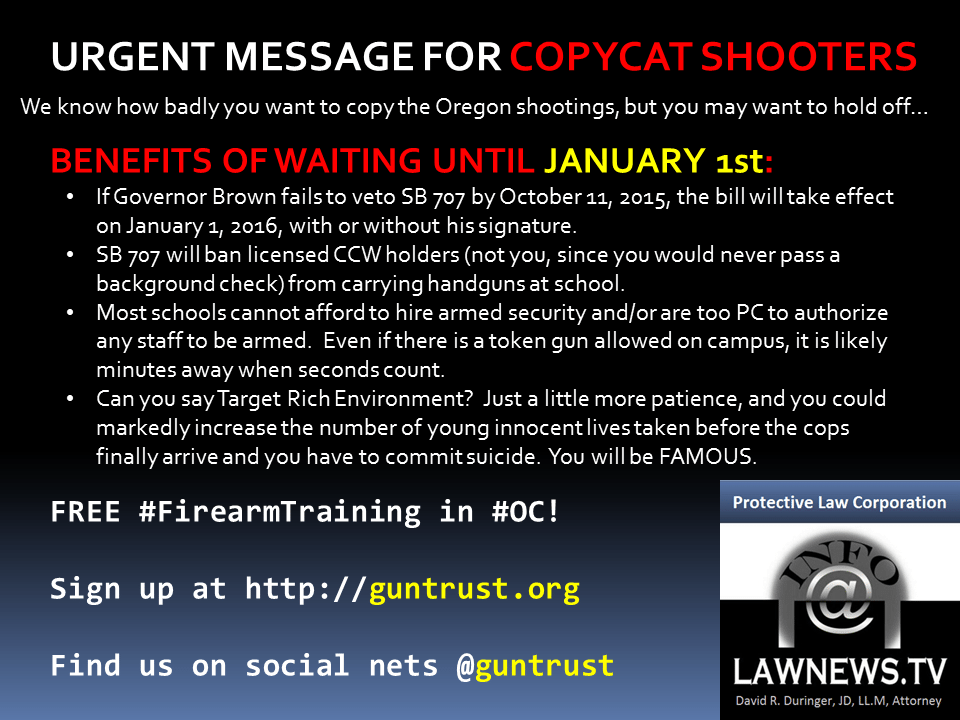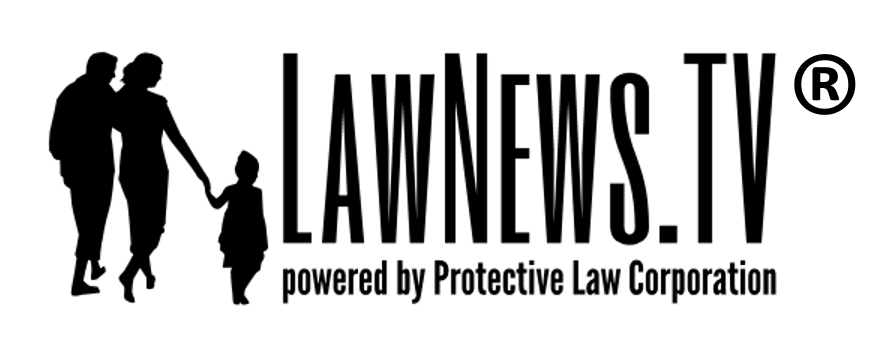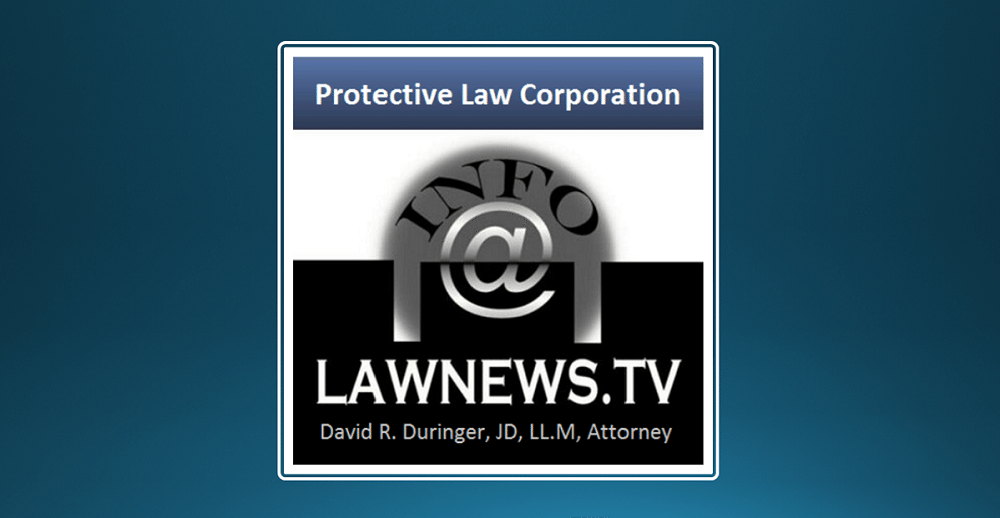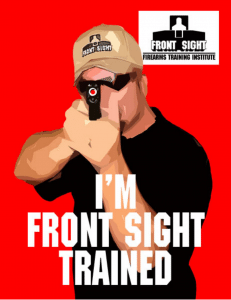 Because of SB 707, California’s new law removing the exemption which previously allowed concealed carry licensees to carry at schools, I dropped my daughter off at the church parking lot instead this morning. The walk to campus is thus now a bit longer for her, and unfortunately it was raining today. It also takes me longer to get back on the road, especially with all the convicted felons and unconvicted terrorists and crazy people dropping THEIR kids off at the church parking lot.
Because of SB 707, California’s new law removing the exemption which previously allowed concealed carry licensees to carry at schools, I dropped my daughter off at the church parking lot instead this morning. The walk to campus is thus now a bit longer for her, and unfortunately it was raining today. It also takes me longer to get back on the road, especially with all the convicted felons and unconvicted terrorists and crazy people dropping THEIR kids off at the church parking lot.
The Anderson high school district up in Shasta County has a better solution:
Despite a recent statewide ban on concealed firearms at high school and college campuses, the Anderson Union High School District has other plans.
Source: Concealed weapons allowed on high school district’s campuses | KRCR Home – KRCR Home
SB 707 removed the exemption for concealed carry licensees that was in Penal Code section 626.9(l) and now even if you have a CCW you need to get “written permission of the school district superintendent, his or her designee, or equivalent school authority” under that section 626.9, which now reads:
(a) This section shall be known, and may be cited, as the Gun-Free School Zone Act of 1995.(b) Any person who possesses a firearm in a place that the person knows, or reasonably should know, is a school zone, as defined in paragraph (1) of subdivision (e), unless it is with the written permission of the school district superintendent, his or her designee, or equivalent school authority, shall be punished as specified in subdivision (f).(c) Subdivision (b) does not apply to the possession of a firearm under any of the following circumstances:(1) Within a place of residence or place of business or on private property, if the place of residence, place of business, or private property is not part of the school grounds and the possession of the firearm is otherwise lawful.(2) When the firearm is an unloaded pistol, revolver, or other firearm capable of being concealed on the person and is in a locked container or within the locked trunk of a motor vehicle.This section does not prohibit or limit the otherwise lawful transportation of any other firearm, other than a pistol, revolver, or other firearm capable of being concealed on the person, in accordance with state law.(3) When the person possessing the firearm reasonably believes that he or she is in grave danger because of circumstances forming the basis of a current restraining order issued by a court against another person or persons who has or have been found to pose a threat to his or her life or safety. This subdivision may not apply when the circumstances involve a mutual restraining order issued pursuant to Division 10 (commencing with Section 6200) of the Family Code absent a factual finding of a specific threat to the person’s life or safety. Upon a trial for violating subdivision (b), the trier of a fact shall determine whether the defendant was acting out of a reasonable belief that he or she was in grave danger.(4) When the person is exempt from the prohibition against carrying a concealed firearm pursuant to Section 25615, 25625, 25630, or 25645.(5) When the person holds a valid license to carry the firearm pursuant to Chapter 4 (commencing with Section 26150) of Division 5 of Title 4 of Part 6, who is carrying that firearm in an area that is not in, or on the grounds of, a public or private school providing instruction in kindergarten or grades 1 to 12, inclusive, but within a distance of 1,000 feet from the grounds of the public or private school.(d) Except as provided in subdivision (b), it shall be unlawful for any person, with reckless disregard for the safety of another, to discharge, or attempt to discharge, a firearm in a school zone, as defined in paragraph (1) of subdivision (e).The prohibition contained in this subdivision does not apply to the discharge of a firearm to the extent that the conditions of paragraph (1) of subdivision (c) are satisfied.(e) As used in this section, the following definitions shall apply:(1) “Concealed firearm” has the same meaning as that term is given in Sections 25400 and 25610.(2) “Firearm” has the same meaning as that term is given in subdivisions (a) to (d), inclusive, of Section 16520.(3) “Locked container” has the same meaning as that term is given in Section 16850.(4) “School zone” means an area in, or on the grounds of, a public or private school providing instruction in kindergarten or grades 1 to 12, inclusive, or within a distance of 1,000 feet from the grounds of the public or private school.(f) (1) Any person who violates subdivision (b) by possessing a firearm in, or on the grounds of, a public or private school providing instruction in kindergarten or grades 1 to 12, inclusive, shall be punished by imprisonment pursuant to subdivision (h) of Section 1170 for two, three, or five years.(2) Any person who violates subdivision (b) by possessing a firearm within a distance of 1,000 feet from the grounds of a public or private school providing instruction in kindergarten or grades 1 to 12, inclusive, shall be punished as follows:(A) By imprisonment pursuant to subdivision (h) of Section 1170 for two, three, or five years, if any of the following circumstances apply:(i) If the person previously has been convicted of any felony, or of any crime made punishable by any provision listed in Section 16580.(ii) If the person is within a class of persons prohibited from possessing or acquiring a firearm pursuant to Chapter 2 (commencing with Section 29800) or Chapter 3 (commencing with Section 29900) of Division 9 of Title 4 of Part 6 of this code or Section 8100 or 8103 of the Welfare and Institutions Code.(iii) If the firearm is any pistol, revolver, or other firearm capable of being concealed upon the person and the offense is punished as a felony pursuant to Section 25400.(B) By imprisonment in a county jail for not more than one year or by imprisonment pursuant to subdivision (h) of Section 1170 for two, three, or five years, in all cases other than those specified in subparagraph (A).(3) Any person who violates subdivision (d) shall be punished by imprisonment pursuant to subdivision (h) of Section 1170 for three, five, or seven years.(g) (1) Every person convicted under this section for a misdemeanor violation of subdivision (b) who has been convicted previously of a misdemeanor offense enumerated in Section 23515 shall be punished by imprisonment in a county jail for not less than three months, or if probation is granted or if the execution or imposition of sentence is suspended, it shall be a condition thereof that he or she be imprisoned in a county jail for not less than three months.(2) Every person convicted under this section of a felony violation of subdivision (b) or (d) who has been convicted previously of a misdemeanor offense enumerated in Section 23515, if probation is granted or if the execution of sentence is suspended, it shall be a condition thereof that he or she be imprisoned in a county jail for not less than three months.(3) Every person convicted under this section for a felony violation of subdivision (b) or (d) who has been convicted previously of any felony, or of any crime made punishable by any provision listed in Section 16580, if probation is granted or if the execution or imposition of sentence is suspended, it shall be a condition thereof that he or she be imprisoned in a county jail for not less than three months.(4) The court shall apply the three-month minimum sentence specified in this subdivision, except in unusual cases where the interests of justice would best be served by granting probation or suspending the execution or imposition of sentence without the minimum imprisonment required in this subdivision or by granting probation or suspending the execution or imposition of sentence with conditions other than those set forth in this subdivision, in which case the court shall specify on the record and shall enter on the minutes the circumstances indicating that the interests of justice would best be served by this disposition.(h) Notwithstanding Section 25605, any person who brings or possesses a loaded firearm upon the grounds of a campus of, or buildings owned or operated for student housing, teaching, research, or administration by, a public or private university or college, that are contiguous or are clearly marked university property, unless it is with the written permission of the university or college president, his or her designee, or equivalent university or college authority, shall be punished by imprisonment pursuant to subdivision (h) of Section 1170 for two, three, or four years. Notwithstanding subdivision (k), a university or college shall post a prominent notice at primary entrances on noncontiguous property stating that firearms are prohibited on that property pursuant to this subdivision.(i) Notwithstanding Section 25605, any person who brings or possesses a firearm upon the grounds of a campus of, or buildings owned or operated for student housing, teaching, research, or administration by, a public or private university or college, that are contiguous or are clearly marked university property, unless it is with the written permission of the university or college president, his or her designee, or equivalent university or college authority, shall be punished by imprisonment pursuant to subdivision (h) of Section 1170 for one, two, or three years. Notwithstanding subdivision (k), a university or college shall post a prominent notice at primary entrances on noncontiguous property stating that firearms are prohibited on that property pursuant to this subdivision.(j) For purposes of this section, a firearm shall be deemed to be loaded when there is an unexpended cartridge or shell, consisting of a case that holds a charge of powder and a bullet or shot, in, or attached in any manner to, the firearm, including, but not limited to, in the firing chamber, magazine, or clip thereof attached to the firearm. A muzzle-loader firearm shall be deemed to be loaded when it is capped or primed and has a powder charge and ball or shot in the barrel or cylinder.(k) This section does not require that notice be posted regarding the proscribed conduct.(l) This section does not apply to a duly appointed peace officer as defined in Chapter 4.5 (commencing with Section 830) of Title 3 of Part 2, a full-time paid peace officer of another state or the federal government who is carrying out official duties while in California, any person summoned by any of these officers to assist in making arrests or preserving the peace while he or she is actually engaged in assisting the officer, a member of the military forces of this state or of the United States who is engaged in the performance of his or her duties, or an armored vehicle guard, engaged in the performance of his or her duties, as defined in subdivision (d) of Section 7582.1 of the Business and Professions Code.(m) This section does not apply to a security guard authorized to carry a loaded firearm pursuant to Article 4 (commencing with Section 26000) of Chapter 3 of Division 5 of Title 4 of Part 6.(n) This section does not apply to an existing shooting range at a public or private school or university or college campus.(o) This section does not apply to an honorably retired peace officer authorized to carry a concealed or loaded firearm pursuant to any of the following:(1) Article 2 (commencing with Section 25450) of Chapter 2 of Division 5 of Title 4 of Part 6.(2) Section 25650.(3) Sections 25900 to 25910, inclusive.(4) Section 26020.(5) Paragraph (2) of subdivision (c) of Section 26300.(p) This section does not apply to a peace officer appointed pursuant to Section 830.6 who is authorized to carry a firearm by the appointing agency.
If attacked, do you want to be Victor or Victim?
At SacredHonor.US, we hate it when people die embarrassed.
And at Protect.FM, we believe good estate plans protect families.
We make it easy for your family to attain the comfort of skill at arms.
David R. Duringer, JD, LL.M, is a concealed firearm instructor and tax lawyer specializing in business and estate planning. He is managing shareholder at Protective Law Corporation, serving Southern California from its Laguna Hills (Orange County) headquarters and a satellite office in Coronado (San Diego County).
© Protective Law Corporation as per date of publication captioned above. All rights reserved unless otherwise noted. Sharing encouraged with attribution and/or link to this page.









